Loco sheds and other railway buildings...
Discussion
Stevepolly said:
Kings X on 25th July 1981 with 55 014 and 55 015 on the blocks....

How would they have got these loco's up to the front of the train, or did they just use a fresh one for the next trip
The loco that had brought the train would be uncoupled, then another loco would be attached to the other end - either on another service or a station pilot would take the empty carriages off to be stabled/serviced at carriage sidings. 
How would they have got these loco's up to the front of the train, or did they just use a fresh one for the next trip
Edited by Stevepolly on Monday 24th January 23:22
The loco at the buffer stops could (carefully) follow the carriages it had brought in down the platform as they were drawn out until it reached the signal at the end of the platform, where it had to wait for the line to be clear. Then it could be shuffled across to another platform to work an outbound service (brought in by another loco now 'trapped' at the buffers), head to the refuelling/stabling point just outside the station throat or be sent up the line to Finsbury Park.
This is one of the big operational advantages of multiple units and power cars - a huge reduction in shunting/light engine movements at terminii, quicker turnarounds and the railway can eliminate a lot of pointwork and signalling. Very efficient but it makes the railway much less interesting than they were.
Venisonpie said:
How do the cabs fare with multiple users? Having driven trucks for a living 25 years ago one of the downsides was taking over a vehicle from a messy fecker who left rubbish/coffee cups/fag ash etc.
Eventually I had a dedicated vehicle but obviously not possible on the railway.
Some of the 66's I've been in have been quite nice, some full of water and mud etc. Eventually I had a dedicated vehicle but obviously not possible on the railway.
2xChevrons said:
This is one of the big operational advantages of multiple units and power cars - a huge reduction in shunting/light engine movements at terminii, quicker turnarounds and the railway can eliminate a lot of pointwork and signalling. Very efficient but it makes the railway much less interesting than they were.
Also in the case of main line steam locos, it would have to be physically turned round (on a turntable) so that it would be the right way round for the outgoing service.Lily the Pink said:
Also in the case of main line steam locos, it would have to be physically turned round (on a turntable) so that it would be the right way round for the outgoing service.
Or in some locations there's a "triangle" formation in a track junction that saves the need for a turntable, effectively doing a big three-point turn.AJB88 said:
Venisonpie said:
How do the cabs fare with multiple users? Having driven trucks for a living 25 years ago one of the downsides was taking over a vehicle from a messy fecker who left rubbish/coffee cups/fag ash etc.
Eventually I had a dedicated vehicle but obviously not possible on the railway.
Some of the 66's I've been in have been quite nice, some full of water and mud etc. Eventually I had a dedicated vehicle but obviously not possible on the railway.
Stevepolly said:
Thanks for all the info,its great.
For people like me could someone put up a little picture gallery with all the classes so we (uninitiated) know what the hell you'r talking about?
Steve.
Righto, here's a quick run down of most of the diesel and electric locos from BR days, built from the late '50s to '80s....For people like me could someone put up a little picture gallery with all the classes so we (uninitiated) know what the hell you'r talking about?
Steve.
Class 03 shunter :

Class 08 shunter, around a thousand of these were built and they were allocated pretty much everywhere and there are still several in service :

Class 14 shunter also used on local freight workings, these had Hydraulic transmissions and were the last type of locos built at Swindon Works, they had very short lives on the the Western Region until about 1969 when most were withdrawn but some ended up in private use up north :

Class 20 freight locos, often used in pairs on all sorts of traffic and occasionally used on passenger trains in the Summer months, there are still some in service :

Class 21 mixed traffic locos, built by North British in Scotland for the Eastern and Scottish Regions they all ended up in Scotland and had very short lives, some were re-engined and converted to Class 29s but they were all withdrawn by 1971 :

Class 22 mixed traffic locos with Hydraulic transmissions built by North British in Scotland for the Western Region, all withdrawn by New Year's Day 1972, they look similar to the Class 21s but were a bit shorter :

Class 23 mixed traffic locos built for local workings out of Kings X, nicknamed 'Baby Deltics' they were very troublesome and were all withdrawn by about 1969 :

Class 24 mixed traffic locos, used mainly on the Midland Region but occasionally elsewhere, all gone by 1980 :
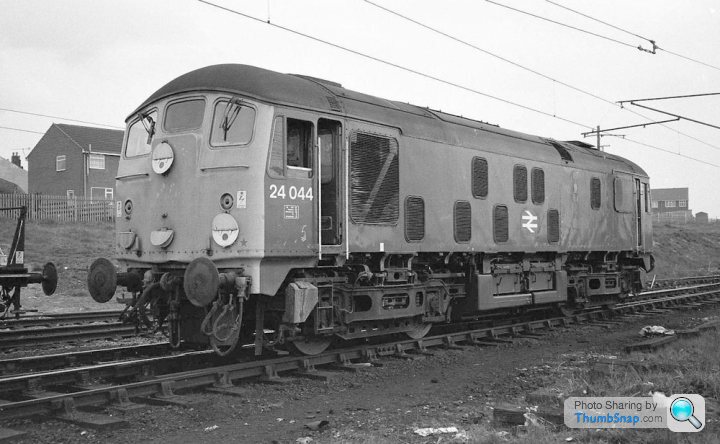
Class 25 similar to above, used almost everywhere and gone by the mid '80s :

Class 26 similar to above in some ways, built for use on the Eastern and Scottish Regions but they all migrated to Scotland by about 1969 :

Class 27 similar to the Class 26s, built for use on the Midland and Scottish Regions but they had all migrated to Scotland by about 1969 :

Class 31 mixed traffic locos, used almost everywhere at different times, there are still some in use on Network Rail testing trains :

Class 33 mixed traffic locos, built for use on the Southern Region but also spread across the country in later years, still one or two in use I believe :

Class 35 'Hymek' mixed traffic locos with Hydraulic transmissions, built for use on the Western Region but occasionally worked into Southern and Midland Region areas, all withdrawn by 1975 :
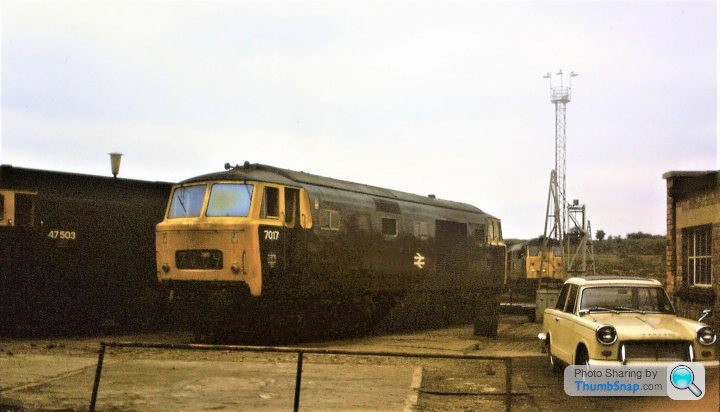
Class 37 mixed traffic locos used on all of the regions and there are still some in use :

Class 40 mixed traffic locos, built for the Eastern and Midland Regions but used almost everywhere later on, all withdrawn by the mid '80s :

Class 44, 45 and 46 mixed traffic locos, also known collectively as 'Peaks' as the first ten were named after mountains etc, built for use mainly on the Midland Region but the 45s and 46s went almost everywhere, the 44s were all withdrawn by 1980, the others buy the late '80s :


Class 47 mixed traffic locos, built for use over the entire country and some are still in use today :
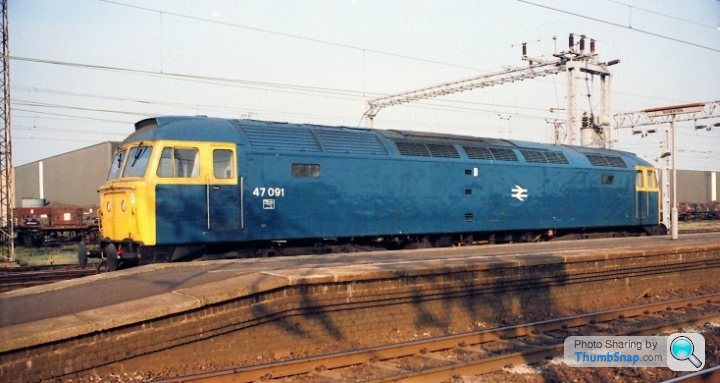
Class 50 mixed traffic locos built for the Midland Region and used mostly on the West Coast Mainline north of Crewe until they were all transferred to the Western Region in the '70s, only fifty were built and I've driven all of them, superb locos when in good nick and very thrashable on a good day, a few are still in use on the mainline :

Apart from one other loco (a Class 56) they were the first to be given the 'large logo' livery in the '80s....

Class 52 mixed traffic locos with Hydraulic transmissions built for the Western Region but they spread onto the Southern and Midland Regions occasionally :
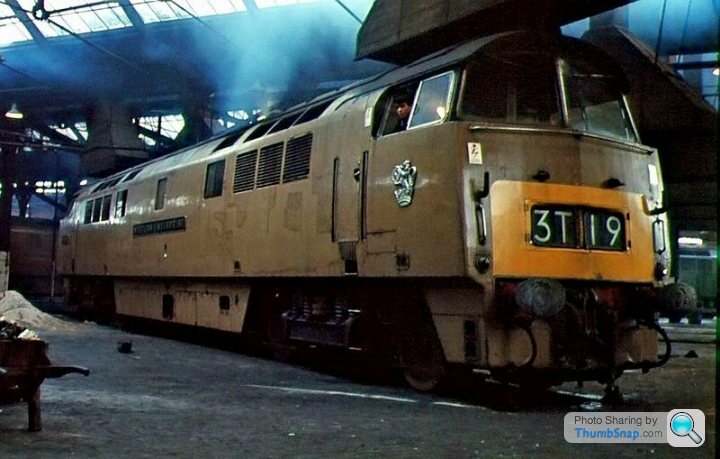
All finish the list off later

P5BNij said:
Wrote a fantastic post
Wasn't there a class 09 shunter that looked a lot like the class 08, maybe they were modified 08s ?The other thing I find confusing/never remember is when they're referred to as e.g. 'Brush Type 4' or 'English Electric (EE) Type 4'.
Would be great if you could include that with your summary.
Pinkie15 said:
Wasn't there a class 09 shunter that looked a lot like the class 08, maybe they were modified 08s ?
The other thing I find confusing/never remember is when they're referred to as e.g. 'Brush Type 4' or 'English Electric (EE) Type 4'.
Would be great if you could include that with your summary.
The 09s were near-as-make no difference identical to the 08s, but they had higher gearing to gain top speed (27mph instead of the 15mph of an 08) at the expense of tractive effort. This was so they could be used to replace ancient steam locos that the Southern Region used around London on exchange freight, empty carriage stock and station pilot work.The other thing I find confusing/never remember is when they're referred to as e.g. 'Brush Type 4' or 'English Electric (EE) Type 4'.
Would be great if you could include that with your summary.
Both were just variants on the standard English Electric 350hp shunter design, which had been used by all four of the Big Four private companies and was also widely exported. There were other BR classes that were variations on the theme - Class 10s were 08s with Blackstone rather than EE engines, 11s were a batch originally ordered by the LMS and so different in some details to the 'standard' 08, 12s had been ordered by the Southern Railway but delivered to BR, and so had Bulleid-Firth-Brown disc wheels rather than spokes and so on.
Similary, Classes 24, 25, 26 and 27 were all the same basic design with the same Sulzer engine but the 24 and 25 were built in BR's own workshops and had BTH electrical gear (the 25 had a more powerful intercooled engine) while the 26 and 27 were built by BRCW with Crompton electrics (the 26 being the original and the 27 having the intercooled prime mover).
All thanks to BR being required to spread its spending around as many firms and regions as possible, thus ensuring that they ended up with lots of similar-but-different designs, many of which were designed or built by firms that really shouldn't have been given the work.
P5BNij said:
Righto, here's a quick run down of most of the diesel and electric locos from BR days, built from the late '50s to '80s....
Class 03 shunter :

Class 08 shunter, around a thousand of these were built and they were allocated pretty much everywhere and there are still several in service :

Class 14 shunter also used on local freight workings, these had Hydraulic transmissions and were the last type of locos built at Swindon Works, they had very short lives on the the Western Region until about 1969 when most were withdrawn but some ended up in private use up north :

Class 20 freight locos, often used in pairs on all sorts of traffic and occasionally used on passenger trains in the Summer months, there are still some in service :

Class 21 mixed traffic locos, built by North British in Scotland for the Eastern and Scottish Regions they all ended up in Scotland and had very short lives, some were re-engined and converted to Class 29s but they were all withdrawn by 1971 :

Class 22 mixed traffic locos with Hydraulic transmissions built by North British in Scotland for the Western Region, all withdrawn by New Year's Day 1972, they look similar to the Class 21s but were a bit shorter :

Class 23 mixed traffic locos built for local workings out of Kings X, nicknamed 'Baby Deltics' they were very troublesome and were all withdrawn by about 1969 :

Class 24 mixed traffic locos, used mainly on the Midland Region but occasionally elsewhere, all gone by 1980 :

Class 25 similar to above, used almost everywhere and gone by the mid '80s :

Class 26 similar to above in some ways, built for use on the Eastern and Scottish Regions but they all migrated to Scotland by about 1969 :

Class 27 similar to the Class 26s, built for use on the Midland and Scottish Regions but they had all migrated to Scotland by about 1969 :

Class 31 mixed traffic locos, used almost everywhere at different times, there are still some in use on Network Rail testing trains :

Class 33 mixed traffic locos, built for use on the Southern Region but also spread across the country in later years, still one or two in use I believe :

Class 35 'Hymek' mixed traffic locos with Hydraulic transmissions, built for use on the Western Region but occasionally worked into Southern and Midland Region areas, all withdrawn by 1975 :

Class 37 mixed traffic locos used on all of the regions and there are still some in use :

Class 40 mixed traffic locos, built for the Eastern and Midland Regions but used almost everywhere later on, all withdrawn by the mid '80s :

Class 44, 45 and 46 mixed traffic locos, also known collectively as 'Peaks' as the first ten were named after mountains etc, built for use mainly on the Midland Region but the 45s and 46s went almost everywhere, the 44s were all withdrawn by 1980, the others buy the late '80s :


Class 47 mixed traffic locos, built for use over the entire country and some are still in use today :

Class 50 mixed traffic locos built for the Midland Region and used mostly on the West Coast Mainline north of Crewe until they were all transferred to the Western Region in the '70s, only fifty were built and I've driven all of them, superb locos when in good nick and very thrashable on a good day, a few are still in use on the mainline :

Apart from one other loco (a Class 56) they were the first to be given the 'large logo' livery in the '80s....

Class 52 mixed traffic locos with Hydraulic transmissions built for the Western Region but they spread onto the Southern and Midland Regions occasionally :

All finish the list off later
There are posts and there are great posts.Class 03 shunter :

Class 08 shunter, around a thousand of these were built and they were allocated pretty much everywhere and there are still several in service :

Class 14 shunter also used on local freight workings, these had Hydraulic transmissions and were the last type of locos built at Swindon Works, they had very short lives on the the Western Region until about 1969 when most were withdrawn but some ended up in private use up north :

Class 20 freight locos, often used in pairs on all sorts of traffic and occasionally used on passenger trains in the Summer months, there are still some in service :

Class 21 mixed traffic locos, built by North British in Scotland for the Eastern and Scottish Regions they all ended up in Scotland and had very short lives, some were re-engined and converted to Class 29s but they were all withdrawn by 1971 :

Class 22 mixed traffic locos with Hydraulic transmissions built by North British in Scotland for the Western Region, all withdrawn by New Year's Day 1972, they look similar to the Class 21s but were a bit shorter :

Class 23 mixed traffic locos built for local workings out of Kings X, nicknamed 'Baby Deltics' they were very troublesome and were all withdrawn by about 1969 :

Class 24 mixed traffic locos, used mainly on the Midland Region but occasionally elsewhere, all gone by 1980 :

Class 25 similar to above, used almost everywhere and gone by the mid '80s :

Class 26 similar to above in some ways, built for use on the Eastern and Scottish Regions but they all migrated to Scotland by about 1969 :

Class 27 similar to the Class 26s, built for use on the Midland and Scottish Regions but they had all migrated to Scotland by about 1969 :

Class 31 mixed traffic locos, used almost everywhere at different times, there are still some in use on Network Rail testing trains :

Class 33 mixed traffic locos, built for use on the Southern Region but also spread across the country in later years, still one or two in use I believe :

Class 35 'Hymek' mixed traffic locos with Hydraulic transmissions, built for use on the Western Region but occasionally worked into Southern and Midland Region areas, all withdrawn by 1975 :

Class 37 mixed traffic locos used on all of the regions and there are still some in use :

Class 40 mixed traffic locos, built for the Eastern and Midland Regions but used almost everywhere later on, all withdrawn by the mid '80s :

Class 44, 45 and 46 mixed traffic locos, also known collectively as 'Peaks' as the first ten were named after mountains etc, built for use mainly on the Midland Region but the 45s and 46s went almost everywhere, the 44s were all withdrawn by 1980, the others buy the late '80s :


Class 47 mixed traffic locos, built for use over the entire country and some are still in use today :

Class 50 mixed traffic locos built for the Midland Region and used mostly on the West Coast Mainline north of Crewe until they were all transferred to the Western Region in the '70s, only fifty were built and I've driven all of them, superb locos when in good nick and very thrashable on a good day, a few are still in use on the mainline :

Apart from one other loco (a Class 56) they were the first to be given the 'large logo' livery in the '80s....

Class 52 mixed traffic locos with Hydraulic transmissions built for the Western Region but they spread onto the Southern and Midland Regions occasionally :

All finish the list off later

2xChevrons said:
Pinkie15 said:
Wasn't there a class 09 shunter that looked a lot like the class 08, maybe they were modified 08s ?
The other thing I find confusing/never remember is when they're referred to as e.g. 'Brush Type 4' or 'English Electric (EE) Type 4'.
Would be great if you could include that with your summary.
The 09s were near-as-make no difference identical to the 08s, but they had higher gearing to gain top speed (27mph instead of the 15mph of an 08) at the expense of tractive effort. This was so they could be used to replace ancient steam locos that the Southern Region used around London on exchange freight, empty carriage stock and station pilot work.The other thing I find confusing/never remember is when they're referred to as e.g. 'Brush Type 4' or 'English Electric (EE) Type 4'.
Would be great if you could include that with your summary.
Both were just variants on the standard English Electric 350hp shunter design, which had been used by all four of the Big Four private companies and was also widely exported. There were other BR classes that were variations on the theme - Class 10s were 08s with Blackstone rather than EE engines, 11s were a batch originally ordered by the LMS and so different in some details to the 'standard' 08, 12s had been ordered by the Southern Railway but delivered to BR, and so had Bulleid-Firth-Brown disc wheels rather than spokes and so on.
Similary, Classes 24, 25, 26 and 27 were all the same basic design with the same Sulzer engine but the 24 and 25 were built in BR's own workshops and had BTH electrical gear (the 25 had a more powerful intercooled engine) while the 26 and 27 were built by BRCW with Crompton electrics (the 26 being the original and the 27 having the intercooled prime mover).
All thanks to BR being required to spread its spending around as many firms and regions as possible, thus ensuring that they ended up with lots of similar-but-different designs, many of which were designed or built by firms that really shouldn't have been given the work.
Pinkie15 said:
2xChevrons said:
Pinkie15 said:
Wasn't there a class 09 shunter that looked a lot like the class 08, maybe they were modified 08s ?
The other thing I find confusing/never remember is when they're referred to as e.g. 'Brush Type 4' or 'English Electric (EE) Type 4'.
Would be great if you could include that with your summary.
The 09s were near-as-make no difference identical to the 08s, but they had higher gearing to gain top speed (27mph instead of the 15mph of an 08) at the expense of tractive effort. This was so they could be used to replace ancient steam locos that the Southern Region used around London on exchange freight, empty carriage stock and station pilot work.The other thing I find confusing/never remember is when they're referred to as e.g. 'Brush Type 4' or 'English Electric (EE) Type 4'.
Would be great if you could include that with your summary.
Both were just variants on the standard English Electric 350hp shunter design, which had been used by all four of the Big Four private companies and was also widely exported. There were other BR classes that were variations on the theme - Class 10s were 08s with Blackstone rather than EE engines, 11s were a batch originally ordered by the LMS and so different in some details to the 'standard' 08, 12s had been ordered by the Southern Railway but delivered to BR, and so had Bulleid-Firth-Brown disc wheels rather than spokes and so on.
Similary, Classes 24, 25, 26 and 27 were all the same basic design with the same Sulzer engine but the 24 and 25 were built in BR's own workshops and had BTH electrical gear (the 25 had a more powerful intercooled engine) while the 26 and 27 were built by BRCW with Crompton electrics (the 26 being the original and the 27 having the intercooled prime mover).
All thanks to BR being required to spread its spending around as many firms and regions as possible, thus ensuring that they ended up with lots of similar-but-different designs, many of which were designed or built by firms that really shouldn't have been given the work.

The Western Region 'Warship' types I missed before -
Class 41 or 'D600' Warships - only five of these were built for the Western Region by North British in Glasgow, the WR didn't really want them and all five were withdrawn on New Year's Eve 1967, they were simply switched off in fully working condition and stored for a few months before being towed to South Wales for scrapping, two of them ended up at Dai Woodhams 'graveyard' in Barry so lasted a little longer, D601 was cut up in 1970 but D600 lasted until 1980....
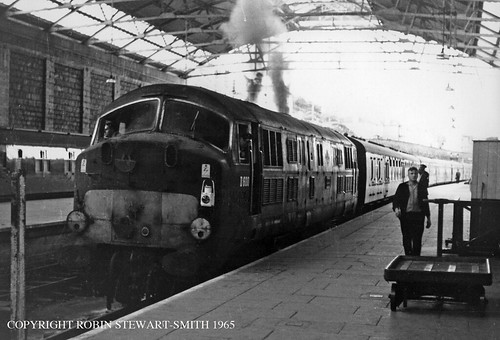

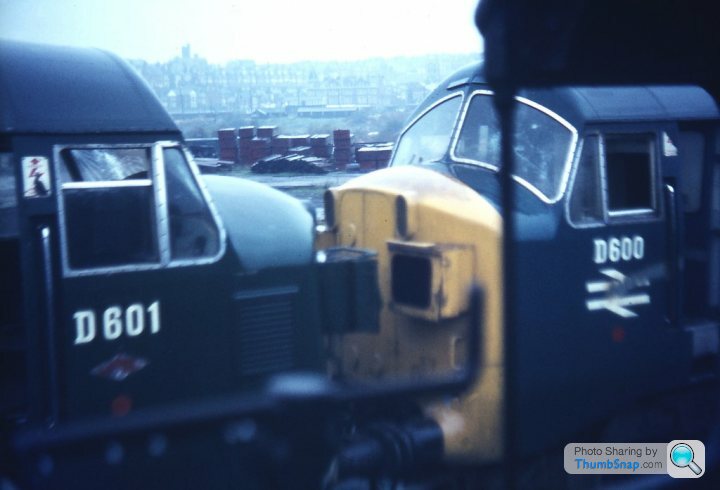
Class 42 and 43 'D800' Warships - built in two batches with the 42s coming from Swindon Works and the 43s from North British, they were near identical in appearance with some detail changes but most of the differences were internal, the 42s had Maybach engines while the 43s had MAN engines, the 43s were all gone by October '71 and the 42s by December '72 (two of the 42s have been preserved)....
Class 42 D815 'Druid' outside Swindon Works in 1966, the place it was built just a few years previously....
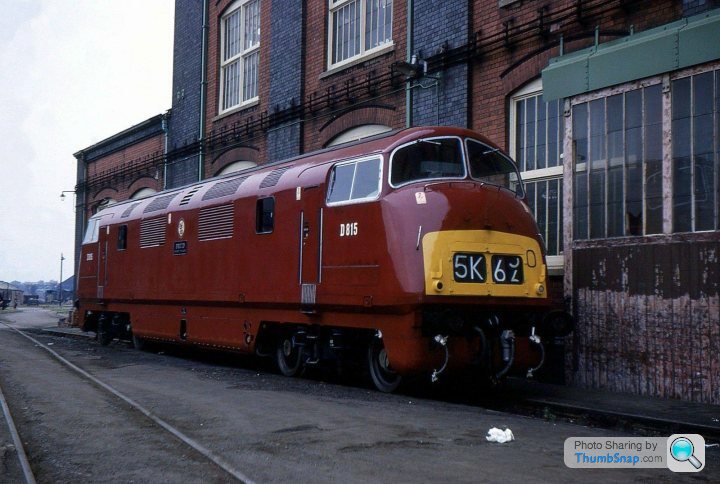
Class 42s D822 'Hercules' and D827 'Kelly' paired up on a Royal train working at Oxford in May 1968....

Nice comparison between Warship D814 'Dragon' and Western D1000 'Western Enterprise' at Bristol Temple Meads in 1966....

One of the Western Region Blue Pullman eight car sets passing through Leamington Spa c1963 on a Wolverhampton Low Level to Paddington run....
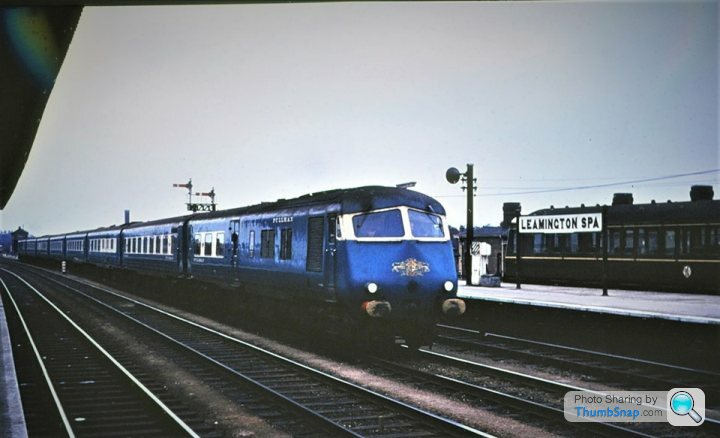
wolfracesonic said:
‘Very thrashable’, care to expand?
The 50s we had at Old Oak were used day in, day out on the Paddington to Oxford and Newbury commuter trains which had quite tight timings, once you were clear of the 25mph speed restriction through the pointwork you could open them right up and keep the power on until shutting off for the first stop. They really used to fly and could take quite a bit of abuse but the power handle had an initial 'notch' which you had to be careful with, if you tried to go to full power straight away without pausing on that notch you'd get a slight thump in the back then nothing.
P5BNij said:
wolfracesonic said:
‘Very thrashable’, care to expand?
The 50s we had at Old Oak were used day in, day out on the Paddington to Oxford and Newbury commuter trains which had quite tight timings, once you were clear of the 25mph speed restriction through the pointwork you could open them right up and keep the power on until shutting off for the first stop. They really used to fly and could take quite a bit of abuse but the power handle had an initial 'notch' which you had to be careful with, if you tried to go to full power straight away without pausing on that notch you'd get a slight thump in the back then nothing.
Gassing Station | Boats, Planes & Trains | Top of Page | What's New | My Stuff



